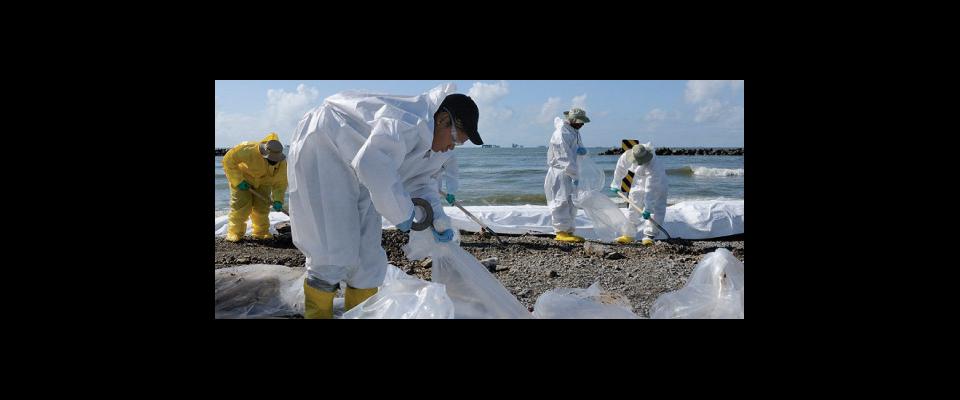Why the BP oil spill may not be as bad as we thought.
On April 20, an accident aboard the Deepwater Horizon drilling rig off the coast of Louisiana released a geyser of oil into the Gulf of Mexico. Early news reports looked devastating: pelicans dripping with oil, hermit crabs struggling through sludge, and out-of-work fishermen faced with an endangered shrimp industry. Engineers failed several times to stem the flow until finally, on July 20, they managed to cap it—only after 206 million gallons of oil had escaped into the ocean.
A few weeks later, the waters began to clear. Government officials recently stated that only 25 percent of the oil remains in the water—some had been successfully removed, but the majority of it dissipated or decomposed naturally. This news came as a surprise to many, but it’s exactly what Berkeley Professor Emeritus Alex Horne predicted. Horne established the discipline of eco-engineering—which he describes as finding sustainable solutions to environmental problems—at Berkeley. Since retiring in 2003, he’s become an international consultant on oil spills and remediation. In the edited conversation below, Horne puts the spill into perspective.
California: On the scale of human-caused oil spills, how would you rank the BP disaster?
Alex Horne: As a single event, I would rank it in the top 10, possibly in the top 20. I’m basing this partially on size, partially on where it was relative to the damage that we could do and its physical location on the ocean, and partially on the temperature.
As an ecological engineer, I have to look at which place is the worst [for an oil spill]. Well, the engineering view is that the worst damage occurs where there are the most things to damage. Down at 7, 10, 15 thousand meters, it’s pretty cold, there isn’t a lot of activity, and there isn’t a lot of life. The odd whale carcass goes down there once every blue moon, and we get a lot of talk about rifts and volcanoes and stuff, but there’s just nothing like the productivity of a typical marsh wetland that you’d find in California along the coast or along the bay.
The most toxic material [in oil] is a substance called phenol. I’ve measured its effects, and it’s damn toxic. Oil contains phenols, and refined oils contain more, but all oils contain some phenol. What happens to phenol is, because it’s soluble and because there are currents in the ocean, it gets dissolved very rapidly.
The volatile components of oil evaporate faster in warm water—we don’t want it in the atmosphere, either, but it does less damage, again, because of the even greater dilution. When the oil hits the shoreline, if it hits warm conditions, then the bugs can get to work on it much faster.
Has some of the reaction to the spill been overblown?
Well, that’s a loaded question, but the an-swer is yes. It seems overblown, but it’s very useful to have a huge number of people concerned so we can do something about it. Someone may pass legislation because everybody’s jumping up and down about it, and that legislation may be hurriedly cobbled together and perhaps not fully appropriate. But it’s the way we get things done.
The oil spill is now largely gone. Does that mean our clean-up efforts were successful, or would we have been better off doing nothing?
What I’ve read and known about oil spills is that for many of them what we did was really rather futile. I don’t have the numbers to say what percent of the oil was collected, because we probably don’t have the exact amount that was spilled, but my guess is that it would be a small percentage. And it’s hard if somebody’s saying, well, that represents 5,000 birds oiled up and dying.
I think a lot of money was spent on floundering around, trying to do their best, to look as if they were doing something. It’s a human need to do that. Using pure logic, without any emotion involved, you might say that most of that money might have been much better spent on two things. One is—as a professor I have to say—on some more research to find out what’s really going on with the oil. But that’s a small amount of money—hundreds of millions handles all the research in the country. Most of it might have gone to something like, “We’ll buy this piece of marsh on the shore that’s threatened to do something on a big scale that would have a long-term beneficial effect.” After ten years people might say, “Yeah, the ocean was damaged 12 percent, but here we’ve improved something 200 percent.” And that’s the sort of calculation on our crowded planet that we have to make a bit more often.
Should we accept that oil spills are a way of life and learn how to cope with them?
I think the analogy is the automobile-safety business. Automobiles are a lot safer than when I was a boy, partly because of the pressure put on the manufacturers. We need to keep pressure on the manufacturers—in this case the oil drillers—to do the best job that they can. But there’s a limit to what you can do 1,500 feet down in the ocean. And if we are to use more of our own oil and become less dependant on other countries, then yes, I think we should accept that oil spills will occur, even big ones now and again, and we should have some kind of response to deal with it.
What should come out of these disasters is not just, “OK, we’ll design some wetlands to take care of it,” but “We’ll solve the entire problem.” Let’s get an energy independence policy based on sustainability.




















